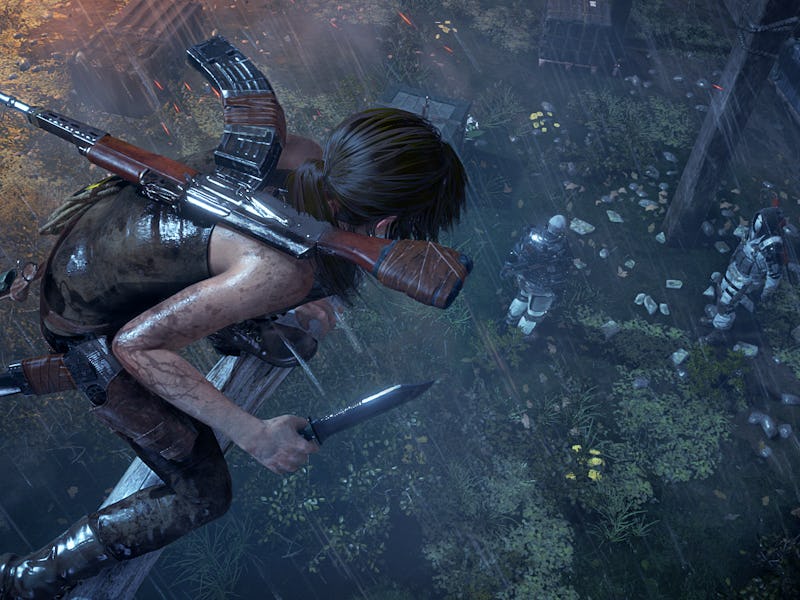When Being a Game Ruins Your Storytelling
Actions are loud, even the stealth kills.

About an hour into playing the 2013 Tomb Raider from Crystal Dynamics, there is a tense moment in the narrative when Lara Croft – younger and inexperienced here, not a gun-toting James Bond/Indiana Jones hybrid that Angelina Jolie once portrayed her as – is hiding. From who, we do not know, but they are dangerous men. Angry, dangerous men, yelling in Russian.
It’s not long before one of them finds Lara. He runs his hand down her body, but Lara (controlled by you) knees him in the gnards. The music intensifies. You wrestle each other over his gun. A frenetic button mash is your tug-of-war for the gun and eventually your aim. A pull of the right trigger button blows his brains out. Lara is covered in blood, and she watches him die.
She’s hysterical and breaks down. Relief, anger, sadness, regret, despair, hope, Lara Croft feels it all in one poignant, sobering moment. She killed, to survive, but she killed. For decades we have spent our gaming years studying the vocabulary of shooting and hacking and slashing, but very rarely do we ever deal with its consequences. Even rarer do we do it in a franchise best remembered for a British model with gun holsters strapped to yoga-toned thighs. But this isn’t the ‘90s; hell it’s not even the first decade of the new millennium anymore. The medium has matured. Even in AAA-franchise video games we can intelligently and eloquently deal with death, actions, and consequences.
Moments later you’re unloading bullets into a bunch of dudes.
Tomb Raider is an action game. It made no promises that it would be a character meditation on man versus nature. But it feels so sudden, and in doing so this abruptness allowed gaming to ruin its storytelling.
Through the first hour, you playing as Lara Croft are lulled into basic survival. Against lush scenery and forests, Lara is armed with only a bow with the local fauna as her targets. You kill, but nothing man hasn’t been expected to do over years of evolution. But after that first murder of a person, Lara laments her situation, reacting to scars she’ll be carrying for life (if she survives).
But then promptly she is thrust into clearing out enemies like a Schwarzenegger movie. Within a few more hours of playing, Lara will be armed with a shotgun and an assault rifle in addition to her bow and pistol, and further upgrades will allow explosive rounds and grenade launcher attachments. You’re still surviving, but you’re swatting flies with a sledgehammer.
This is the beginning of Lara Croft, but will she be the Lara we once knew her as? This origin/reboot of Croft doesn’t make clear if she eventually becomes the globe-trotting badass we spent our adolescence fantasizing for. Lara has always been smart, but in the 2013 reboot she’s far more bookish. Even after she empties a room of enemies, if she stumbles upon a relic she won’t hesitate to nerd out over its purpose and significance. Besides survival, discovery of the haunted island is her central preoccupation, and even towards the end of the game she is far more focused on going to a crucial ritual chamber than killing the game’s antagonist, a crazed priest and cult leader who commands shipwrecked pirates. They stand in her way of knowledge, armed with fire arrows and guns, so Lara unleashes bullet hell into them like her old self.
The tonal dissonance is one of the biggest detractions to an otherwise incredible game from just a few short years ago. Within Camilla Luddington’s performance, you never feel that Lara Croft enjoys mowing down her enemies… although there is one fist-pumping moment when Lara acquires the grenade launcher and for the first time they run away from her while Lara screams “You better run!” But otherwise, I attributed the storytelling flaw as some kind of misstep, a hiccup in the evolution, like yawning. Surely we’d know better next time?
And then, Rise of the Tomb Raider. Spectacular as it may look, I grew concerned when more gameplay footage out of E3 and Gamescom showed Lara killing once again with ease. It wasn’t until just this week did we see Lara Croft, the Tomb Raider, actually do some tomb raiding.
Again – these are action video games. If Tomb Raider was nothing but Lara Croft hunting caribou or rabbits, sales would plummet. But in between treating every death with remorse and becoming a stone-cold badass, a happy medium should be sought after. Video games, like television and comic books before it, have achieved a maturity where complex storytelling isn’t only possible but should be an unspoken, unacknowledged requirement. We should have more because we deserve more.
Tomb Raider has afforded itself an unexplored opportunity of reinvention. It has the chance to reinvent to incorporate the actions of the player to mean something for the narrative, and for the game’s narrative to truly inform gaming actions. Sure, kill this person, but should you really? Gaming is fundamentally about choice — eat this fruit, strafe left, no, move right — and some of the actions we don’t take should mean just as much as the ones we do.
But maybe I’m wrong, and this really is the origin story of the Lara Croft we had known in our younger days. Maybe what’s new is old again, and soon in a future iteration of this series we will see Croft once again strap a holster to her survival-tested thighs. But if, or when she does, I hope she feels something.